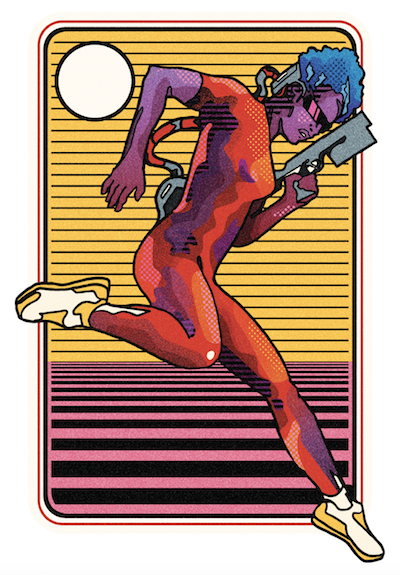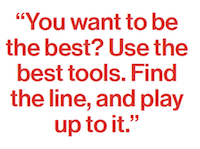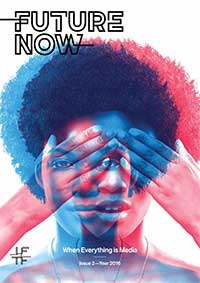Future Now
The IFTF Blog
eSports Gets a "New Mindset" for 2026
The Shock demolish Electroforce, but does the use of new tech go against the spirit of the league?
Sweat flecked the inside of the player tubes in Madison Square Garden as the New York Shock scraped out their first-ever league championship. The lucky diehard fans with tube-side seats had all risen up, faces pressed against the plexiglass to watch the players’ real-life bodies sprint-in-place, leap, pivot and aim. The majority saw the action play out on the stadium-center projections, watching the Shock’s avatars dash through miles of virtual mountain, forest and city-scape and pump the Lagos Electroforce full of laser beams.
 But the only spectators who saw the true significance of the victory were those whose eyes were fixed on the stadium’s dome ceiling and the simple colored dots representing the players’ movements on the field. The New York squad’s dots moved with spooky levels of coordination—spreading out, surrounding their opponents, and then moving in like a school of piranhas dismantling its prey. Welcome to a new era of XBeam.
But the only spectators who saw the true significance of the victory were those whose eyes were fixed on the stadium’s dome ceiling and the simple colored dots representing the players’ movements on the field. The New York squad’s dots moved with spooky levels of coordination—spreading out, surrounding their opponents, and then moving in like a school of piranhas dismantling its prey. Welcome to a new era of XBeam.
The rumors, it turned out, were true. The Shock were wearing “Mindsets,” neuro-sensor devices that measure signals of focus, anger, and concern as they arise in players’ brains. New York Shock star Lena Boxton and her team took full advantage of the controversial devices. As they coordinated that epic pincer attack in the 4th quarter, the New York Shock players sent and received signals from one another, creating a basic but instantaneous hyper-communication. The only IRL hint was the little red bands situated above the Shock players’ VR goggles.
Meanwhile, Lagos Electroforce played au natural with voicecomm alone. They looked sluggish, dazed, and amateurish in comparison.
By the end of the match, some of the more delicate Lagos fans averted their gaze and even removed their haptic body suits, choosing not to physically experience the sporting carnage, leaving their favorite team to experience defeat alone. Finally, Lagos, embarrassed and confused, conceded. Heads down, the players staggered from their tubes with glazed looks and stumbled to the locker room.
New Strategies and VR Recaps
No doubt experts and analysts alike will pore over the match in VR this week. Nobody will study it quite like Lagos Electroforce’s coach Lexi Harris. Her game plan seemed honed and brilliant, elegant even, for the game’s opening. Lagos star player, and NRL darling, Art Bucclaw seemed to direct his troops on the digital field with textbook ease. Lagos’s supporting crew of brawlers and specialists seemed in their element. But seemed doesn’t pay the bills. Coach Harris will re-watch the game from each of her players’ perspectives in VR to find out just where their strategy crumbled, no doubt leading to a few cuts from the squad and free agents come spring.
 All credit to the New York Shock though. I’d still be clapping if my hands could take it but they’re red all over and it’s 2AM. New York star Lena Boxton pulled such brilliant plays from her back pocket the announcers dubbed her the Manhattan Mastermind late in the game. The name better stick. Lena’s always been known for creative gameplay and exploring new strategies first. Adoring fans will no doubt hang posters in their bedrooms of the pincer move she executed in the game’s final minutes. Heck, I’ll buy one of those posters, and I’m 37.
All credit to the New York Shock though. I’d still be clapping if my hands could take it but they’re red all over and it’s 2AM. New York star Lena Boxton pulled such brilliant plays from her back pocket the announcers dubbed her the Manhattan Mastermind late in the game. The name better stick. Lena’s always been known for creative gameplay and exploring new strategies first. Adoring fans will no doubt hang posters in their bedrooms of the pincer move she executed in the game’s final minutes. Heck, I’ll buy one of those posters, and I’m 37.
The Mindsets might leave an acrid taste in the mouths of sporting purists, but they’re missing the big picture. In my book, this is not as dramatic a change as the pundits would have you believe.
The More Things Change...
 The push for sporting superiority, the drive to win at any cost, is nothing new to sports of any kind. But anyone who knows their eSports history knows that creative use of enhancements have often been a defining factor. After all, you’re already playing a video game—playing naturally isn’t really an option anyway.
The push for sporting superiority, the drive to win at any cost, is nothing new to sports of any kind. But anyone who knows their eSports history knows that creative use of enhancements have often been a defining factor. After all, you’re already playing a video game—playing naturally isn’t really an option anyway.
The early days of eSports were like the wild west. Match-fixing, performance-enhancing drugs, illegal software hacks, and taking advantage of bugged code were rampant. It’s easy to forget that eSports were once a fringe phenomena. Players coded aimbots to artificially improve a player’s aim and software hacks that allowed players to see through walls. Many readers likely don’t remember this, as eSports hadn’t yet hit the mainstream.
But that started to change in the mid 2010s, when AR and VR devices hit markets and new eSport titles sprouted up like weeds. This was the beginning of eSports as we know it today, games that use natural user interfaces to track player hand and body gestures. The physical athleticism gave the games appeal to both the core eSport audience and the broader sporting world, rocketing physical eSports into the cultural spotlight. And while the performance-enhancing-drugs problem of traditional sports plagued the leagues, these physical eSports were much harder to hack—until now.
Some commentators are calling Boxton and her team’s use of the Mindsets a betrayal of the values of eSports. If you ask me, it’s the return of the creative spirit that defined its early days.
For her part, Boxton doesn’t seem troubled by the controversy. I sat down with her in the afterglow of the Shock’s finals victory to get her take. She still hadn’t changed out of her Shock blues.
“We’re competitors to the core, but we played a clean game. You want to be the best? Use the best tools. Find the line, and play up to it,” she asserted, unsmiling. “You think the cyclists from 1926 could outrace one from today, with how far bikes have come? Never. The Mindsets are just another kind of tool. Nothing wrong with that.”
“Nothing wrong indeed,” I said, sensing a bit of defensiveness. “In fact, some might say, on the contrary, you just pioneered a major breakthrough.”
“That’s true,” she said, in a somewhat friendlier tone. “This is a completely new strategy we came up with. And Mindsets are hard to use, Alex. We’ve been practicing with them for months.”
A light blinked on Lena’s Mindset, and her eyes perked up for a split second. “My teammates are celebrating, I should go.”
She stood to leave and I congratulated her again. Indeed, congratulations to everyone on the New York Shock for a masterful, hard-earned championship victory. You were nothing short of stunning and a thrill to watch. I tip my hat to you. Enjoy your parade—the Big Apple’s going to be a madhouse tomorrow.
 FUTURE NOW—When Everything is Media
FUTURE NOW—When Everything is Media
In this second volume of Future Now, IFTF's print magazine, we explore the future of communications. In our research process, we traced historical technology shifts through the present and focused on the question, “what is beyond social media?”
Think of Future Now as a book of provocations; it reflects the curiosity and diversity of futures thinking across IFTF and our network of collaborators. It contains expert interviews, profiles and analyses of what today’s technologies tell us about the next decade, as well as comics and science fiction stories that help us imagine what 2026 (and beyond) might look and feel like.
For More Information
For more information on IFTF's Future 50 Partnership and Tech Futures Lab, contact:
Sean Ness | sness@iftf.org | 650.233.9517



